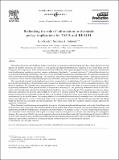Rethinking the Role of Information in Chemicals Policy: Implications for TSCA and REACH
Author(s)
Koch, Lars; Ashford, Nicholas A.
DownloadKoch&Ashford1.pdf (253.0Kb)
Metadata
Show full item recordAbstract
This article analyses the role of different kinds of information for minimizing or eliminating the risks due to the production, use, and
disposal of chemical substances and contrasts it with present and planned (informational) regulation in the United States and the
European Union, respectively. Some commentators who are disillusioned with regulatory approaches have argued that informational
tools should supplant mandatory regulatory measures unflatteringly described as ‘‘command and control.’’ Critics of this reformist view
are concerned with the lack of technology-innovation forcing that results frominformational policies alone.Weargue that informational
tools can be made more technology inducing e and thus more oriented towards environmental innovations e than they are under current
practices, with or without complementary regulatory mechanisms, although a combination of approachesmay yield the best results.
The conventional approach to chemicals policy envisions a sequential process that includes three steps of (1) producing or collecting
risk-relevant information, (2) performing a risk assessment or characterization, followed by (3) risk management practices, often
driven by regulation. We argue that such a sequential process is too static, or linear, and spends too many resources on searching for,
or generating information about present hazards, in comparison to searching for, and generating information related to safer alternatives
which include input substitution, final product reformulation, and/or process changes. These pollution prevention or cleaner
technology approaches are generally acknowledged to be superior to pollution control. We argue that the production of risk information
necessary for risk assessment, on the one hand, and the search for safer alternatives on the other hand, should be approached
simultaneously in two parallel quests. Overcoming deficits in hazard-related information and knowledge about risk reduction alternatives
must take place in a more synchronized manner than is currently being practiced. This parallel approach blurs the alleged
bright line between risk assessment and risk management, but reflects more closely how regulatory agencies actually approach the
regulation of chemicals.
These theoretical considerations are interpreted in the context of existing and planned informational tools in the United States and
the European Union, respectively. The current political debate in the European Union concerned with reforming chemicals policy and
implementing the REACH (Registration, Evaluation and Authorization of Chemicals) system is focused on improving the production
and assessment of risk information with regard to existing chemicals, although it also contains some interesting risk management
elements. To some extent, REACH mirrors the approach taken in the United States under the Toxics Substances Control Act (TSCA)
of 1976. TSCAturned out not to be effectively implemented and provides lessons that should be relevant toREACH. In this context, we
discuss the opportunities and limits of existing and planned informational tools for achieving risk reduction.
Date issued
2006Citation
Journal of Cleaner Production 14(1): 31-46
Keywords
chemicals, policy, TSCA, REACH